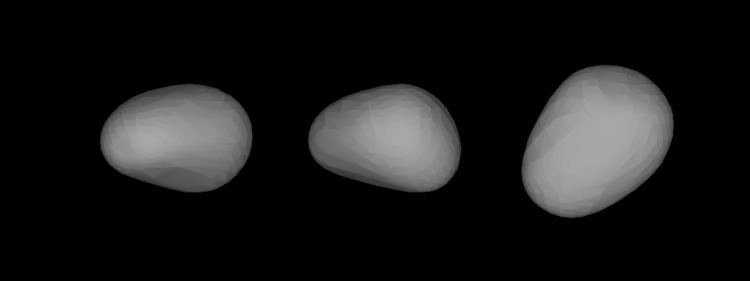Discovered by H. Goldschmidt Alternative names 1977 CE Discovered 27 May 1857 Asteroid group Asteroid belt | Discovery date May 27, 1857 Orbits Sun Discoverer Hermann Goldschmidt | |
 | ||
Aphelion 2.78291235 AU (416.3 Gm) Perihelion 2.06469721 AU (308.9 Gm) Similar Hermann Goldschmidt discoveries, Other celestial objects | ||
44 Nysa /ˈnaɪsə/ is a large and very bright main-belt asteroid, and the brightest member of the Nysian asteroid family. It is classified as a rare class E asteroid and is probably the largest of this type (though 55 Pandora is only slightly smaller).
Contents
Discovery
It was discovered by Hermann Goldschmidt on May 27, 1857, and named after the mythical land of Nysa in Greek mythology.
Physical properties
In 2002 Kaasalainen et al. used 63 lightcurves from the Uppsala Asteroid Photometric Catalog (UAPC) to construct a shape model of 44 Nysa. The shape model is conical, which they interpreted as indicating the asteroid may actually be a contact binary.
In 2003, Tanga et al. published results obtained from the Fine Guidance Sensor on the Hubble Space Telescope in which high-precision interferometry was performed on Nysa with the goal of a more accurate shape determination. Due to Hubble's orbit around the Earth, hours-long photometry sessions, as are normally used to resolve the asteroid's shape, were not possible. Instead, the team used interferometry on the asteroid at the time in its rotation when it would have its longest axis perpendicular to the Earth. Ellipsoidal shape models were then fit to the resulting data to determine an estimate of the asteroid's shape. Both single and double ellipsoid models were fit to the data with both providing approximately the same goodness of fit; leaving the team unable to differentiate between a single elongated object and the contact binary model put forth by Kaasalainen et al. An observation of an occultation by 44 Nysa of TYC 6273-01033-1 from the Dutch amateur astronomer Harrie Rutten showed a two-phase reappearance on March 20, 2012. This confirms the conical shape or the binary nature of Nysa.
In December 2006, Shepard et al. performed three days of radar observations on Nysa with the Arecibo radio telescope. The asteroid was found to have a high radar polarization value (μc) of 0.50 ± 0.2, a radar albedo (
Nysa has so far been reported occulting a star three times.
